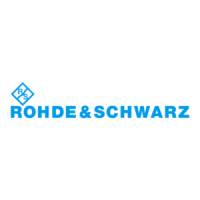Concepts and features
R&S
®
ZNA
132User Manual 1178.6462.02 ─ 20
Examples for using wave quantities
The wave quantities provide the power at the different receive ports of the analyzer.
This is different from an S-parameter measurement, where the absolute power of a lin-
ear device is canceled. Wave quantities are therefore suitable for the following mea-
surement tasks:
●
Analysis of nonlinearities of the DUT.
●
Use of the analyzer as a selective power meter.
To increase the accuracy or to correct a possible attenuation in the source signal
path, it is recommended to perform a power calibration (see Chapter 4.5.6, "Scalar
power calibration", on page 191).
The notation for wave quantities is as follows:
●
"a
i
Src Port j" denotes the wave incoming at DUT port i, when DUT port j is stimula-
ted.
a
i
is detected at the reference receiver of the VNA port connected to DUT port i.
●
"b
i
Src Port j" denotes the wave outgoing at DUT port i, when DUT port j is stimula-
ted.
b
i
is detected at the measurement receiver of the VNA port connected to DUT port
i.
In a standard forward S-parameter measurement, a
1
Src Port 1 is the incident wave
and b
1
Src Port 1 is the reflected wave at DUT port 1.
4.3.5.2 Ratios
A ratio measurement provides the complex ratio of any combination of transmitted or
received wave amplitudes. Ratios complement the S-parameter measurements, where
only ratios of the form b
i
/a
j
(ratios between outgoing and incoming waves at the DUT
ports) are considered.
Examples for using ratios
A measurement of ratios is particularly suitable for the following test scenarios:
●
The test setup or some of its components (e.g. active components or non-recipro-
cal devices) do not allow a system error correction so that a complete S-parameter
measurement is not possible.
●
The test setup contains frequency-converting components so that the transmitted
and the received waves are at different frequencies.
●
A ratio of two arbitrary waves that is not an element of the S-matrix (e.g. a ratio of
the form a
i
/a
j
) is needed.
The notation for ratios is similar to the notation for wave quantities (see Chap-
ter 4.3.5.1, "Wave quantities", on page 131). Given a source port k, any ratio between
wave quantities "a
i
Src Port k" and "b
j
Src Port k" can be measured.
Measurement results

